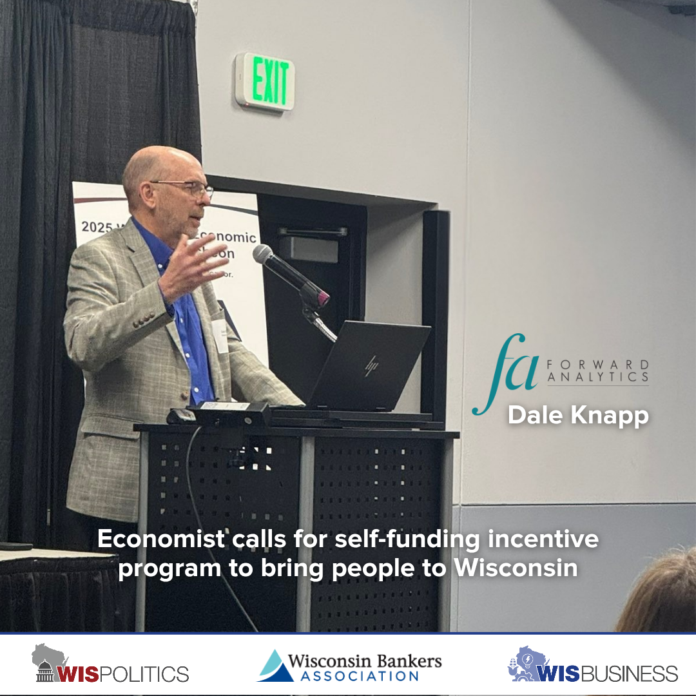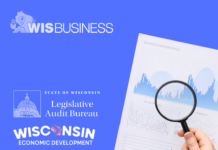Creating a self-funding incentive program to attract people to Wisconsin is the “only way” to offset demographic challenges in the years to come, economist Dale Knapp argues.
Knapp, who leads the Wisconsin Counties Association’s Forward Analytics research division, spoke yesterday during the 2025 Wisconsin Economic Forecast Luncheon. The Madison event was hosted by WisPolitics, WisBusiness.com and the Wisconsin Bankers Association.
Much of Knapp’s remarks were focused on the problems posed by the state’s demographic shift, as the large Baby Boomer generation continues to age out of the workforce and subsequent generations are putting pressure on the state’s labor pool due to their smaller size.
While he said “we’re not going to get out of these challenges” entirely, Knapp proposed using a chunk of the state’s projected $4 billion surplus to mitigate their impact.
He’s calling for putting $300 million of the surplus and putting it into a dedicated attraction fund, with $50 million of that going toward an advertising campaign to spread the word about Wisconsin and its quality of life. Meanwhile, the fund could support a $16,000 incentive for those willing to move to the state, he suggested.
“Let’s say we’re going to be very aggressive and we’re going to be very successful, we’re going to bring in 3,000 families a year,” he said yesterday. “We’re going to repay that fund with the income tax that those families generate over five years, and estimated sales tax that they pay, state sales tax. And that money’s going to go back. That fund never runs out.”
Under his approach, Wisconsin would have “probably the biggest” incentive program of any U.S. state, he said, adding it could be funded forever through the increased tax revenue it would generate. Similar efforts have been attempted elsewhere, including an incentive package aimed at bringing more remote workers to live in Tulsa, Okla.
“It’s the only way, I think, that we’re going to be able to begin to bring enough people into the state to minimize some of those challenges,” Knapp said.
His proposal comes as Wisconsin had fewer than 60,000 births in the state in 2023 — the lowest annual total for the state since 1941, according to Knapp. He pointed to worker shortages across much of Wisconsin, even in areas like Dane County that are continuing to see growth.
“A declining youth population over the past 15 years means that’s going to affect our workforce when we start looking 15, 20, 30 years out,” he said.
Some negative trends are already starting to play out in the state economy, he noted, as the number of large businesses in the state has been “shrinking” between 2017 and 2024. While growth was seen in the number of companies with fewer than 50 workers over that period, the opposite was true for those with larger employee bases.
“We don’t know exactly why all of this is, but I think you can make an educated guess that a lot of it is worker shortage, that some of these businesses are shrinking in terms of size, and there’s probably some of these businesses are leaving the state, especially smaller ones, and going somewhere it’s easier to find workers,” he said.
Meanwhile, he noted wage growth from 2019 to 2024 has been stronger among lower paying jobs. Though that’s “great” for the workers in these positions, Knapp said, the trend is making it harder for employers to hire those workers.
At the same time, he spotlighted a “very unusual” trend in labor force participation in Wisconsin, as the greatest decline in this rate in recent years was among those aged 35-44, which he called a “very critical” segment of the state workforce. Knapp said few states have seen declines in this age group.
“That’s driving part of our stagnant labor force,” he said, adding higher wages are driving expected increases in labor force participation among younger age groups.
Listen to audio of the event here.






